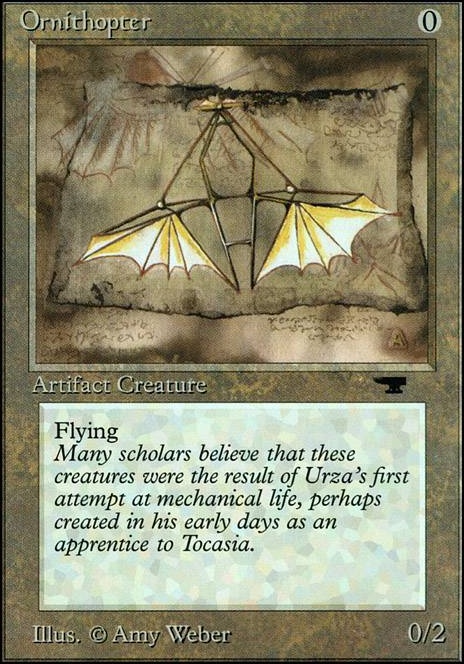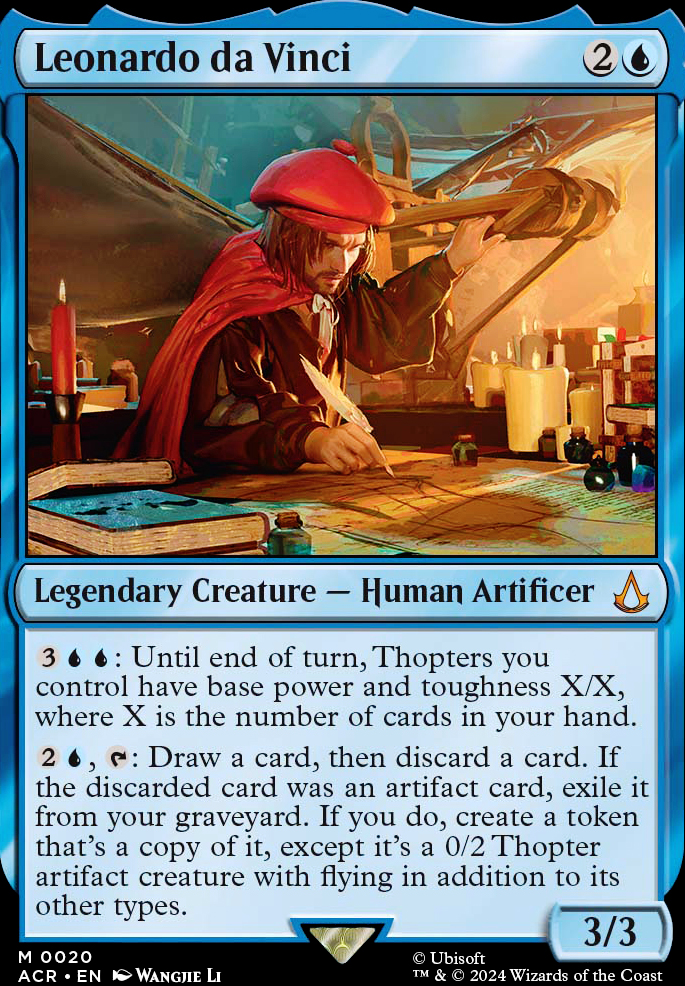Pattern Recognition #319 - Not For the Birds
Features Opinion Pattern Recognition
berryjon
11 April 2024
187 views
11 April 2024
187 views
Hello Everyone! My name is berryjon, and I welcome you all to Pattern Recognition, TappedOut.Net's longest running article series. Also the only one. I am a well deserved Old Fogey having started the game back in 1996. My experience in both Magic and Gaming is quite extensive, and I use this series to try and bring some of that to you. I dabble in deck construction, mechanics design, Magic's story and characters, as well as more abstract concepts. Or whatever happens to catch my fancy that week. Please, feel free to talk about each week's subject in the comments section at the bottom of the page, from corrections to suggested improvements or your own anecdotes. I won't bite. :) Now, on with the show!
Thopters, huh? Well, truth be told, I was running out of ideas and time, and was just using the "Random Card" command on Gatherer when it showed me the Ornithopter, and I had a thought that I could do that. And it scratches my historical itch at the same time!

The word Ornithopter is from the Greek ornith, meaning 'bird' and pteron 'wing'. It is a compound word used to describe any machine that flies by flapping its wings like a bird does, not like a conventional plane that uses large unmoving surfaces and Bernoulli's Principle to provide lift. There have been records of people trying to mimic this means of flight for nearly a millennium, but has probably been tried again and again for even longer.
The most famous Ornithopter were the ones designed by Leonardo da Vinci. In his notes, he pointed out that the human form was too heavy and the arms too weak to fly by simply attaching artificial wings to them and simply mimicking the actions of actual avians. His designs instead tried to bypass these limits through the use of levers, gears and pullies to magnify the effect of human motion. If he built any physical models, we don't know, but his theorycrafting laid the groundwork for heavier-than-air flight centuries later.
But the first actual flying Ornithopters were not built until the 1870's. This is attributed to Jobert, Pénaud, de Villeneuve, Tatin, all in France. However, for those of you wondering why I'm crediting these names before the Wright brothers, the Ornithopters developed by these men over the course of that decade were not capable of carrying a person, and were rather mechanical toys powered by a tightly wound rubber band. These smaller devices would be carried by a man with ease, and were seen as novelty toys by those who bought them. But the concept had been proven to work with artificial materials and not just natural evolution by the birds.
Development continued, with Karl Wilhelm Otto Lilienthal - a German engineer who extensively studied and built gliders. He worked hard to determine the balance between wing sizes and weights to ensure that they were strong enough to hold the weight of both the wings themselves and the person, while at the same time not being to heavy or too small to carry themselves out into the air. Sadly he perished in one of his experiments in 1896.
Despite being the only fatality I have listed, the development of manned flight, especially gliders were fraught with peril as you were essentially throwing yourself off of high buildings or cliffs or steep hills with mostly-unproven wings to try and stay in the air. Landings were rough at the best of times, and people dying was an unfortunately common occurrence.
The development of Ornithopters continuation, mostly in Germany, in the early 1900's, as advancements in internal combustion and steam engines allowed for larger and more effective devices. Materials sciences allowed for the building of lighter and stronger frames and wings, and while it has been under constant development and refinement, most modern Ornithopters are the domain of hobbyists and casual experimenters as while the concept has been technically proven, there are more effective ways of attaining flight.
Manned Ornithopters only became a thing in 1929, when Alexander Lippisch, a German aviation engineer, flew a powered Ornithopter up to 300m. However, because the device did not take off under its own power and had to be towed to flight speed, the validity of this claim is contested. Since then, development has been concurrent with regular Ornithopters, and continues to this day.
In practical terms, Ornithopters occupy a role as an 'artificial bird', and had been tested at airports and other large open spaces as a means of scaring away other birds or animals that might be wary of an airborn predator.
In Magic though?
Yeah. Toss all that out. Magic's Thopters work on magic (definite lowercase there) to get around all the problems that we have in reality. But they have shown up!
The first known Ornithopters were of Thran make, and were used for personal transportation. After the Thran fell, their devices were buried where they lay. And when Mishra and Urza helped Tocasia excavate Thran sites, they were able to refurbish and rebuild an Ornithopter that would take them on their fateful journey to find the Week and Might Stones. In the following war, it was Urza who put production of Thran-inspired Ornithopters as a major part of his army, valuing their ability to bypass terrain and act as messengers, scouts, and raiders. Mishra used them too, but not to the same degree as his brother.
Phyrexia took these designs, and experimented with them, turning the Predator, Flagship into an experimental carrier for the Invasion. However, the ship was destroyed before the results of the experiment could be seen.
Since then, Thopters have been a regular sight on Dominaria, serving in much the same role they always have.
After Dominaria, Kaladesh is the multiverse's greatest user of Thopters. However, unlike the full sized Dominarian versions, Kaladeshi versions were smaller and autonomous, often with a single lens in the front to provide visual guidance and observation. Dovin Baan as part of his part of the leadup to the War of the Spark, imported Kaladeshi Thopters to Ravnica, where they were quickly adopted by the Azorious for use at all levels of their guild.
Other planes use Ornithopters, but not the same degree as those three.
Mechanically, you can divide Thopters into two. First is the cost Ornithopter, a card that represents a device so simple and known that it costs nothing to play it. This creature is a 0/2, and can Fly. It has shown up in Antiquities, Mirrordin and Kaladesh, and you can make a token via Yotia Declares War.
Far more common and numerous is the token:Thopter, a 1/1 artifact creature with Flying. This token artifact creature is one of the most common out there, though not to the same number as say, a 1/1 human Solder. Or a 2/2 Zombie. Or a 1/1 Goblin. I had fun with them in my Saheeli, the Gifted deck over the past couple months, as they can quickly spiral out of control, or just serve as effective chump-blockers.
Interestingly (at least to me) is that Thopters are made in , and are one of, if not the only reliable way for to get any sort of creature with Flying that isn't going all-in on Dragons. Harried Dronesmith is a non-Commander version of a Loyal Apprentice, and Breya's Apprentice is more than happy to help do things with the Thopter he makes. As does Pia Naalar.
There are a couple of interesting Thopter and Thopter-related cards though, so I should look at them.
The first is Ornithopter itself. A ridiculous combo piece, thanks to its casting cost, this creature does dang near everything you can want it to do. Sadly, it's lack of innate power means that it requires an external force to put that above 0 before you can swing for the win with it.
Which is where the Roterothopter comes into play. Designed around the other of da Vinci's designs, this version of the venerable Ornithopter has a limited-use Firebreathing effect to it, which does give it the ability to swing for damage as long as you can pay.
Liberator, Urza's Battlethopter represents Urza's personal Thopter for when he wound up taking to the battlefield himself during the Brother's War. This grows over time and you cast more and more powerful artifact spells, which cna potentially doom your opponents if they don't block or destroy it first.
The first creature to actually create a Thopter token was Thoper Squadron, part of an interesting meta-cycle of cards that included Pentavus that could turn +1/+1 counters into creatures and turn those creatures into +1/+1 counters.
And finally...
 The man for whom an entire era of human history was named - the Renaissance.
The man for whom an entire era of human history was named - the Renaissance.
Look, you may or may not like Universes Beyond, nor Assassin's Creed in particular. And personally, I'm annoyed that no version of this card references his only known probable portrait. (No comment about Caster.) But this version of him does one thing and does it well. He makes Thopters, and then makes them all very big to allow his friends to swing at someone's face. And not just the 0/2 tokens, but all your Thopters! Bring your friends, and take to the skies!
Thopters are a minor aspect to the game, and really they only stand out to me for two reasons. First was because I used them to "good" effect - quotation marks included - when I was much younger and thus a worse player. And second, becuase they are one of the things in Magic that was actually a real thing and has stayed at least in the same realm of reality as it has advanced and been refined. I don't expect Thopters. I certainly didn't expect Krenko's Buzzcrusher in Murders, but it's there.
They just exist, but I'm not going to complain about it at all if they take their time before showing up again. I just wanted to glurge a little about real world history. That's all. Ornithopters are cool! But three are better ways to do what they do in real life and in Magic. But cool is still cool.
Thank you all for reading. I'll see you next week with something else. What? I'm not sure yet. But I'm always willing to lend an ear to suggestions and requests.
Until then, please consider donating to my Pattern Recognition Patreon. Yeah, I have a job (now), but more income is always better, and I can use it to buy cards! I still have plans to do a audio Pattern Recognition at some point, or perhaps a Twitch stream. And you can bribe your way to the front of the line to have your questions, comments and observations answered!